#Humulus
Explore tagged Tumblr posts
Text


Common hops 🍺
15 notes
·
View notes
Audio
THE DOOMED & STONED SHOW
~Season 9, Episode 11~
We're back with great, big episode eleven, wherein Billy Goate (Editor, Doomed & Stoned), John Gist (Vegas Rock Revolution), and Bucky Brown (The Ripple Effect) discuss the September edition of the monthly Doom Charts rankings. We also talk about changes at Bandcamp that have some bands and fans concerned, and then a preview the 2024 line-up for Planet Desert Rock Weekend!
By the underground, for the underground: The Doomed & Stoned Show is streaming on Apple Podcasts, Audible, Google Podcasts, Soundcloud, Spotify, and many more. Check out our page on Patreon with perks for supporting the show. You can show the bands love by clicking their highlighted names, below!

PLAYLIST
INTRO (00:00) 1. Rocky's Pride and Joy (#15) - "Crawl" (00:31)
HOST SEGMENT I (04:42) 2. Graveyard (#17) - "Twice" (25:10) 3. Spider Kitten (#19) - "Safe To Drown" (27:50) 4. Rrrags (#29) - "Heart of the Hive" (30:54)
HOST SEGMENT II (37:14) 5. Spiral Shades (#11) - "Witchy Eyes" (49:25) 6. Shadow of Jupiter (#20) - "Daisy Cutter" (53:12) 7. Cloud Catcher (#25) - "I Am The Storm" (58:44)
HOST SEGMENT III (1:04:26) 8. Formation Ritual (#10) - "Sun Chariot" (1:22:10) 9. Omega Sun (#9) - "The One" (1:28:22) 10. Mondo Drag (#8) - "Burning Daylight (Pt. 2)" (1:33:42)
HOST SEGMENT IV (1:38:21) 11. I Am Low (#7) - "Pigs" (1:51:08) 12. Slomatics (#6) - "I, Neanderthal" (1:54:09) 13. Lord Velvet (#5) - "Lament of Io" (1:58:08)
HOST SEGMENT V (2:04:00) 14. Humulus (#4) - "Black Water" (2:53:50) 15. Fire Down Below (#3) - "The Last Cowboy" (3:00:24) 16. Dead Feathers (#2) - "Full Circle" (3:05:02) 17. Domkraft (#1) - "Black Moon Rising" (3:12:04)
OUTRO - Bonus Tracks (3:16:45) 18. Kal-El (#35) - "Universe" (3:17:53) 19. Superlynx (#22) - "Cycle" (3:25:09) 20. Stone of Duna (#14) - "Deathbright" (3:29:37) 21. Frankie and the Witch Fingers (#21) - "Doom Boom" (3:35:28)
CREDITS:
Theme Song: Dylan Tucker
Incidental Music: Hellvetika
Thumbnail: Domkraft
#D&S Podcast#The Doomed & Stoned Show#doom metal#stoner rock#Rocky's Pride And Joy#Graveyard#Spider Kitten#Rrrags#Spiral Shades#Shadow of Jupiter#Cloud Catcher#Formation Ritual#Omega Sun#Mondo Drag#I Am Low#Slomatics#Lord Velvet#Humulus#Fire Down Below#Dead Feathers#Domkraft#Kal-El#Superlynx#Stone of Duna#Frankie and the Witch Fingers#radio#podcast#heavy rock#heavy psych#metal
0 notes
Text

behold their might 💪
#metaphor refantazio#metaphor#hulkenberg#bardon#glodell#gideaux#rudolf#roussainte tribe#eiselin burchelli meijal hulkenberg#elphas maxim bardon#idaeus glodell#ovis lydnad gideaux#rudolf humulus krause#hulkenberg metaphor#bardon metaphor#glodell metaphor#gideaux metaphor#rudolf metaphor#atlus
256 notes
·
View notes
Text
I think a Metaphor AU where you have to get all your archetypes from crown candidates instead of followers would be really funny so here's me assigning the base game archetypes to all the candidates (for a given value of candidate)
Catherina : Still brawler (Yeah)
Forden : Merchant (Leverages political and financial power to crush opposition)
Julian: Mage (singleminded pursuit of knowledge)
Lina : Gunner (pursuit of progress and ingenuity)
Rella : Masked Dancer (Popular figure who wears multiple personas with different people)
Rudolf : Commander (pursuit of military might)
Goddard : Knight (Defensive and slow)
Loveless : Seeker (Vibes exclusively)
Milo : Faker (Debuffs and status effects, presents an aura of beauty despite not being all that pretty)
Glodell : Berserker (Quick to anger and arrogance)
Gideaux : Warrior (physically strong, seeks a just cause to fight for)
Edeni : Summoner (Yeah)
Louis : Prince (Yeah)
Jin : Thief (What was left over)
Maria is still the Healer because she's next in the line of succession after Will /j
#metaphor refantazio#metaphor spoilers#catherina grann#aestivum svafriam forden#julian ruta castiglione#lina kayden#rella cygnus#rudolf humulus krause#goddard cattley gunnar#loveless o'shea#milo maurizio#idaeus glodell#ovis lydnad gideaux#edeni#louis guiabern#jin dulls
18 notes
·
View notes
Text
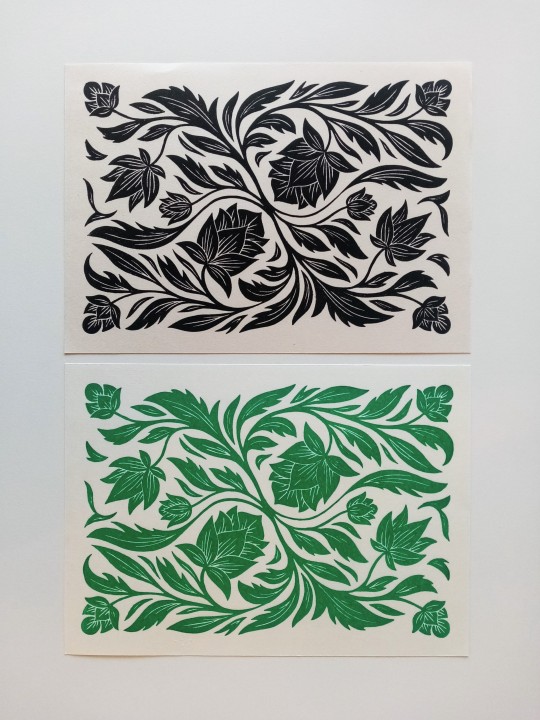
Another floral print (for once created from my own brain without the help of various ornamental design books). It unintentionally ended up looking very hoppy, right down to the serrated leaves, so I've printed it in this thinned-out phthalo green as well.
#linocut#relief print#blockprinting#printmaking#floral#ornament#hops#fun fact for the hop enjoyers among you: the latin name for the hop plant is humulus lupulus (loosely translated as 'wolf of the woods')#not that i can find any justifiable reason for why that may be...
49 notes
·
View notes
Text


Humulus lupulus
#hops#humulus lupulus#plants#naturecore#nature#crowcore#corvidcore#adventurecore#forest#outdoor#crowlivar#goblincore#adventure core#gremlin community
10 notes
·
View notes
Text
My Garden Flowers Part 1
Just thought I'd give you all the garden tour. :) I will update when I get more photos. This is of course not counting any of my ferns or conifers as they don't flower. I might do a series of foliage posts, though. All photos mine, unedited.












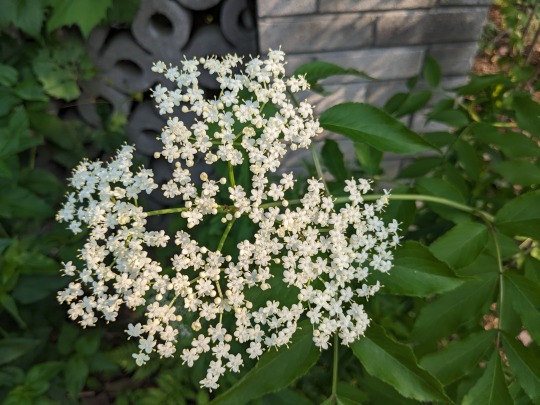

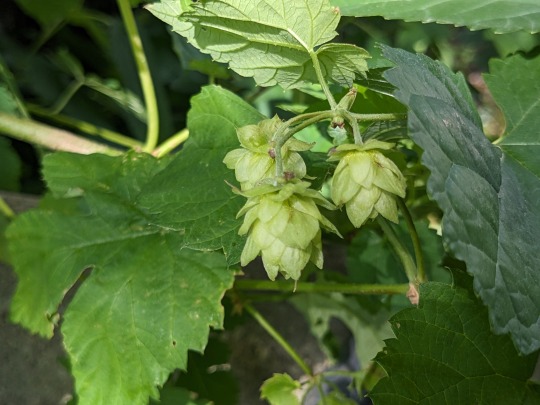


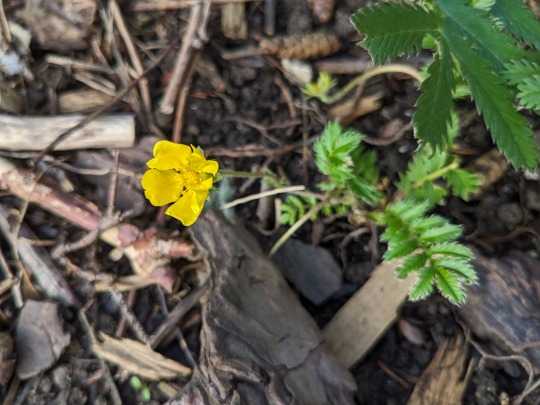

In order of appearance:
001. Canada Plum (Prunus nigra) Not pictured as she hasn't flowered yet. I have her in a shady spot and she's fairly slow-growing but healthy.
002. Yellow Monkeyflower (Mimulus guttata) An annual that sadly doesn't seem to have reseeded despite flowering profusely last year. But maybe next year! That happens sometimes.
003. Boreal Yarrow (Achillea millefolia borealis) The place where she is is north-facing so she doesn't get quite as much sun as she'd like, so she can get a bit leggy but she still flowers so it's fine.
004. Canada Goldenrod (Solidago canadensis) Not pictured as I haven't got any pictures yet, but I will if she flowers this year. I actually had to move her because she had planted herself in a not ideal location in my garden. Which is fine because I wanted one anyway.
005. Vierhapper's Aster (Aster alpinus vierhapperi) This was supposed to be Canada goldenrod, but it's okay because Canada goldenrod planted herself. I relocated her to the intended spot and they get along fine together. Asters and goldenrods generally do. :)
006. Common Sunflower (Helianthus annuus) I did not plant this! Must have been given to me by a bird or squirrel. Sadly she didn't reseed. Oh well, she's a cultivar and I did get the wild type. Interesting to me that she actually flowered in that area when her cousin stubbornly refuses to.
007. Obedient Plant (Physostegia virginiana) This refers to the fact you can move the flowers around, not to the behaviour of the plant, which is very aggressive.
008. Black Chokeberry (Aronia melanocarpa) Not pictured as she hasn't flowered yet.
009. Enchanter's Nightshade (Circaea lutetiana) I didn't plant her; she just started coming up everywhere when I removed the grass. She is not a nightshade. I've learned that even people interested in planting natives regard her as a weed. I disagree. She's not aggressive to other plants and she's pretty.
010. Northern Gooseberry (Ribes oxyacanthoides) Not pictured as she hasn't flowered yet.
011. New Jersey Tea (Ceanothus americanus) Haven't tried her for tea yet, but she's a lovely little bush.
012. Sunchokes (Helianthus tuberosa) Aforementioned cousin of the common sunflower. Not pictured as she keeps making her flowerbuds too late in fall so the frost gets them before they can open.
013. Potato Bean (Apios americana) Not pictured as she hasn't flowered yet.
014. Common Milkweed (Asclepias syriaca) SUPER fragrant, especially in the evening. This is an aggressive plant but worth it for the flowers, the fragrance, and the butterflies they attract. Not to mention the young shoots, flower clusters, young leaves, and young seedpods are all edible if cooked properly!
015. Northern Bayberry (Myrica pennsylvanica) Not pictured as she hasn't flowered yet. Her leaves are nice and evergreen, though.
016. Virginia Strawberry (Fragaria virginiana) Also known as "wild strawberry", but so is her cousin. She flowers reliably every spring but no strawberries yet. The flowers themselves are edible but I keep hoping she'll make strawberries. lol
017. Nannyberry (Viburnum lentago) Not pictured as she hasn't flowered yet.
018. Riverbank Grape (Vitis riparia) Not the greatest picture, but the point is I will get grapes one of these years!
019. False Sunflower (Heliopsis helianthoides) It was hard to pick a favourite photo. They're really quite stunning. She blooms from July until the frosts of October. :)
020. Canadian Serviceberry (Amelanchier canadensis) Not pictured as she hasn't flowered yet. She's a wee little tree in the shade for now.
021. New England Aster (Symphyotrichum novae-angliae) Probably the most attractive of the Symphyotrichum asters, to be honest. The flowers are more compact than most of her relatives while still being a decent size, and the colour is much more saturated too. And the bees absolutely love her. But that doesn't stop me enjoying other asters!
022. Common Elder (Sambucus canadensis) She almost died when I potted her for the move. See I dug up as much of her taproot as I could, but she'd already gone quite deep and I had to break it. But she lived! She's quite big now and has these wonderful lacy white elderflowers every year, with elderberries to follow.
023. Coralberry (Symphoricarpos orbiculata) Not pictured as I didn't get any pictures yet. Should have when I first got her. She was in flower then. She hasn't since.
024. Black Raspberry (Rubus occidentalis) Not pictured as I don't have pictures yet. Don't know why. lol I've taken pictures of the berries. I'll remember next year.
025. Fox Geranium (Geranium robertianum) A true geranium I managed to trade for last year. You mostly find these in the woods and now I have her in my garden.
026-027. Common Hops male and female flowers (Humulus lupulus) I can't remember which is which, but yeah! I could flavour beer if I was a brewer. :)
028. American Spikenard (Aralia racemosa) Another one with lacy little white flowers, and it looks like some of them are going to fruit!
029. Silverweed (Argentina anserina) After several failed attempts, this one has finally taken off. Truly lives up to her name in the spring and has these nice yellow flowers later on.
030. Hoary Vervain (Verbena stricta) The name must refer to the leaves, which are kind of blue-grayish, because the flowers are just a nice purple.
#blackswallowtailbutterfly#my photos#photography#my garden#garden flowers#native plant gardening#native flowers of Carolinian Canada and USA#Mimulus guttata#Achillea millefolium borealis#Aster alpinus vierhapperi#Helianthus annuus#Physostegia virginiana#Circaea lutetiana#Ceanothus americanus#Asclepias syriaca#Fragaria virginiana#Vitis riparia#Heliopsis helianthoides#Symphyotrichum novae-angliae#Sambucus canadensis#Geranium robertianum#Humulus lupulus#Aralia racemosa#Argentina anserina#Verbena stricta
14 notes
·
View notes
Text

{{VENDU}}
ዛꚶᙏꚶԸꚶꕷ ԸꚶᖘꚶԸꚶꕷ έψιλον
HERBARIUM : Houblon (Humulus Lupulus)
LIEU DE CUEILLETTE : mon jardin
#the crypt and the incubus#witch jewelry#electroformed jewelry#botanical jewelry#pendentif#humulus lupulus#houblon
1 note
·
View note
Text





On a hop farm, Poperinge, Flanders, Belgium
#hop#farm#countryside#photography#cottagecore#nature#agriculture#50 shades of green#humulus lupulus#original photographers#photographers on tumblr#lensblr#original photography#pws
5 notes
·
View notes
Text
Plants that grow in both Canada and Finland
* = not native to at least one of the two countries
Acer negundo (box elder)*
Achillea millefolium (common yarrow)
Alliaria petiolata (garlic mustard)*
Alopecurus aequalis (shortawn foxtail)
Anemone hepatica (common hepatica)
Arctagrostis latifolia (wideleaf polargrass)
Argentina anserina (common silverweed)
Artemisia vulgaris (common mugwort)*
Bellis perennis (lawn daisy)*
Berteroa incana (hoary alyssum)*
Betula pendula (silver birch)*
Bryum argenteum (silvery bryum)
Calamagrostis lapponica (Lappland reedgrass)
Calla palustris (marsh calla)
Campanula uniflora (arctic bellflower)
Cannabis sativa (cannabis)
Capsella bursa-pastoris (shepherd's-purse)
Carex adelostoma (circumpolar sedge)
Carex tenuiflora (sparse-flowered sedge)
Ceratodon purpureus (redshank)
Chamaenerion angustifolium (fireweed)
Chenopodium album (common lambsquarters)
Cirsium arvense (creeping thistle)*
Convallaria majalis (European lily of the valley)*
Convolvulus arvensis (field bindweed)*
Corallorhiza trifida (early coralroot)
Cornus suecica (dwarf cornel)
Crocus vernus (spring crocus)*
Cystopteris fragilis (fragile fern)
Datura stramonium (jimsonweed)*
Drosera rotundifolia (round-leaved sundew)
Dryopteris filix-mas (male fern)
Echium vulgare (viper's-bugloss)*
Empetrum nigrum (black crowberry)
Equisetum arvense (field horsetail)
Eriophorum scheuchzeri (Scheuchzer's cottongrass)
Festuca vivipara (viviparous sheep's-fescue)
Fragaria vesca (wild strawberry)
Galium trifidum (three-petal bedstraw)
Geranium pratense (meadow crane's-bill)*
Geranium robertianum (Herb Robert)
Geranium sylvaticum (wood cranesbill)*
Glechoma hederacea (ground-ivy)
Gymnocarpium dryopteris (northern oak fern)
Helianthus annuus (common sunflower)
Humulus lupulus (common hops)
Hyoscyamus niger (black henbane)
Impatiens glandulifera (Himalayan balsam)*
Juniperus communis (common juniper)
Lathyrus japonicus (seaside pea)
Leucanthemum vulgare (oxeye daisy)*
Lupinus polyphyllus (large-leaved lupin)*
Malus baccata (Siberian crabapple)*
Malus domestica (apple)*
Melilotus officinalis (yellow sweetclover)*
Monotropa hypopitys (pinesap)
Oxalis corniculata (creeping woodsorrel)*
Papaver somniferum (opium poppy)*
Petasites frigidus (Arctic sweet coltsfoot)
Phragmites australis (common reed)
Picea abies (Norway spruce)*
Pinus sylvestris (Scots pine)*
Poa arctica (Artic bluegrass)
Prunella vulgaris (common selfheal)
Pteridium aquilinum (common bracken)
Ranunculus lapponicus (Lapland buttercup)
Rosa acicularis (prickly wild rose)
Rubus idaeus (red raspberry)*
Salix lanata (woolly willow)
Saxifraga rivularis
Sceptridium multifidum (leathery grapefern)
Silene dioica (red campion)
Sonchus asper (prickly sowthistle)*
Sorbus aucuparia (European mountain ash)
Tanacetum vulgare (tansy)*
Taraxacum officinale (common dandelion)*
Trifolium pratense (red clover)*
Trifolium repens (white clover)*
Ulva intestinalis (gutweed)
Vaccinium myrtillus (European blueberry)
Vaccinium oxycoccos (bog cranberry)
Vaccinium uliginosum (bog bilberry)
Vaccinium vitis-idaea (lingonberry)
Veronica persica (bird's-eye speedwell)*
Veronica verna (spring speedwell)*
Viola palustris (marsh violet)
Viola tricolor (wild pansy)*
* = not native to at least one of the two countries
21 notes
·
View notes
Text





It was my closest encounter with that beautiful kingfisher and you ruined everything, Japanese hops (Humulus scandens) !!!
#photographers on tumblr#my photography#original photographers#birbs of tumblr#birds on tumblr#lensblr#photography#animal photography#bird photography#wildlife photography#macro photography#nature photography#nature#wildlife#naturecore#wild birds#alcedinidae#kingfisher#common kingfisher#bird#birds#birb#birbs#birblr#birdwatching#but i still like them...#july 16 2024#noai#no to generative ai
32 notes
·
View notes
Text

Got started on my Humulus sweater
166 notes
·
View notes
Text

鉄葎[Kanamugura] Humulus scandens
鉄[Kana] : Iron
葎[Mugura] : Trailing plant
An annual vine plant of the family Cannabaceae. Also known as 葎草[Rissō|Kanamugura]. 草[Sō] means grass.
It is a so-called weed and grows in a variety of places, including fields, wastelands, roadsides, etc. The countless very tiny spines on the stems, stalks and underside of the leaves hook onto various objects, it thrives and covers other grasses and trees. The leaves are deeply lobed and shaped like those of Momiji(maple).
Some believe that this plant is 八重葎[Yaemugura], which has been written in poetry since ancient times.
山賤の おとがひ閉づる 葎かな
[Yamagatsu no otogai tozuru mugura kana] So much mugura is growing that if that mountain folk doesn't close his mouth, the leaves will go inside By Matsuo Bashō
21 notes
·
View notes
Text
Peacock butterfly - Aglais io
A little info-post on Aglais io, the one I found on one of my walks . . .
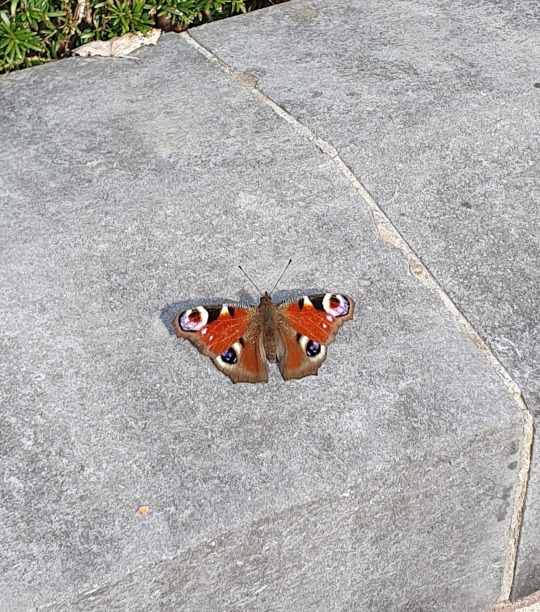

Description
The butterfly hibernates over winter before laying its eggs in early spring, in batches of up to 400 - 500 at a time. The olive green eggs are ribbed. They are laid on both the upper parts and the undersides of leaves of nettle plants and hops.
The caterpillars hatch after about a week. They are shiny black with six rows of barbed spikes and a series of white dots on each segment. The chrysalis may be either grey, brown or green, and may have a blackish tinge. The caterpillars grow up to 42 millimetres in length.
The butterfly has a wingspan of 50 to 55 millimetres. The base colour of the wings is a rusty red, and at each wingtip it bears a distinctive, black, blue and yellow eyespot. The underside is a cryptically coloured dark brown or black.
Feeding behaviour
The primary food plants of European peacock larvae are stinging nettle (Urtica dioica), hop (Humulus lupulus), and the small nettle (Urtica urens).
The adult butterflies drink nectar from a wide variety of flowering plants, including buddleia, willows, dandelions, wild marjoram, danewort, hemp agrimony, and clover; they also use tree sap and rotten fruits.
Distribution
Aglais io can be found in Europe and temperate Asia as far east as Japan. The peacock butterfly is resident in much of its range, often wintering in buildings or trees. It therefore often appears quite early in spring. The peacock can be found in woods, fields, meadows, pastures, parks, and gardens, from lowlands up to 2,500 metres elevation.
Mating system and territorial behaviour
Aglais io employs a monogamous mating system. This is due to their life cycle in which females are receptive only during an eclosion period, after overwintering. The pairs only mate once after overwintering, as it is very difficult to find a receptive female after that period. In species where the range of the females is not defensible by a male, the males must defend a single desirable area that females will come through, such as dense food areas, watering holes, or favourable nesting sites. The males then attempt to mate with the females as they are passing through.
Holding a desirable territory increases the male's likelihood of finding a mate and therefore increases his reproductive success. Aglais io exhibits this type of territorial behaviour, and must defend a desirable territory from other males. This territorial behaviour is reinforced by the fact that the most desirable sites are all concentrated. If the valuable resources were dispersed, there would be less observable territorial behaviour.
To find mates and defend their territory, Aglais io exhibits perching behaviour. The male butterflies will perch on an object where they can observe passing flying objects. Every time they see a passing object of their own species, they will fly straight towards the object. If they encounter a male, the resident male will chase him off his territory. If the resident male encounters a female, he will pursue her until she lands and mating will occur.
Anti-predator defense mechanisms
Like many other butterflies that hibernate, the peacock butterfly exhibits many anti-predator defence mechanisms against predators. The peacock butterfly's most obvious defense comes from the four large eyespots that it has on its wings. It also uses camouflage and can emit a hissing sound. The eyespots are brilliantly coloured concentric circles.
Avian predators
The first line of defence against these predators for many hibernating butterflies is crypsis, a process in which the butterflies blend into their environment by mimicking a leaf and staying immobile. Some hibernating butterflies such as the peacock have a second line of defence: when attacked, they open their wings and expose their eyespots in an intimidating threat display, which gives the butterfly a much better chance at escaping predators than butterflies that rely solely on leaf mimicry.
Rodent predators
While hibernating in dark wintering areas, the peacock butterfly frequently encounters rodent predators such as small mice. Against these predators, however, the visual display of eyespots is ineffective due to the darkness of the environment. Instead, these rodent predators show a much stronger adverse reaction to the butterfly when it produces its auditory hissing signal. This indicates that for rodent predators, it is the auditory signal produced by the butterfly that serves as a deterrent.
~~~~~~~~~~~~~~~~~~~~~~~~~~~~~~~~~~~~~~~~~
Image sources:
2.
~~~~~~~~~~~~~~~~~~~~~~~~~~~~~~~~~~~~~~~~~
Text references:
1.
2.
#hyperfixation#biology#entomology#peacock butterfly#european peacock#aglais io#butterfly#nature#bugs#insects#buglr#<3
8 notes
·
View notes
Text
Moth of the Week
Peppered Moth
Biston betularia

The peppered moth is a part of the family geometridae. It was first described in 1758 by Charles Linnaeus. This moth gains its name from its speckled coloration, which has been studied as an example of natural selection and population evolution.
Description This species has a short body with narrow forewings. The body and wings are the same white base peppered with black dots and irregular black lines. This speckled pattern may vary with some moths having very few spots and others having so many that they look as if they are black with white spots as opposed to white with black. In rare cases, the black on the wings and body is replaced with gray or brown and in even rarer cases the spots are a combination of brown and black/gray. These spots help the moth camouflage against lichen on trees.
The evolution of this moth had been studied extensively during the last two hundred years, which created the term “industrial melanism.” During the Industrial Revolution, air pollution killed off lichen and covered trees in soot. This caused moths with a black spots on white base (typica) coloration to lose their camouflage and die off due to predators. This caused a spike in population for moths with a darker coloration (carbonaria) because they had the camouflage advantage. Once environmental conditions improved, the lighter colored moths once again became the dominant coloration.
The male’s antennae are bipectinate, meaning it has two rows of rami going down either side of a singular flagellum.
Wingspan Range: 45 - 62 mm (≈1.77 - 2.44 in)
Diet and Habitat The caterpillar of this moth eats many trees, shrubs, and small plants such as Blackthorn (Prunus spinosa), Hawthorn (Crataegus monogyna), Downy (Betula pubescens) and Silver Birch (Betula pendula), limes, sallows, poplars, oaks, Sweet Chestnut (Castanae sativa), Beech (Fagus sylvatica), Bramble (Rubus fruiticosus), Broom (Cytisus scoparius), Black Currant (Ribes nigrum) and Hop (Humulus lupulus).
They have a wide range, being found in China (Heilongjiang, Jilin, Inner Mongolia, Beijing, Hebei, Shanxi, Shandong, Henan, Shaanxi, Ningxia, Gansu, Qinghai, Xinjiang, Fujian, Sichuan, Yunnan, Tibet), Russia, Mongolia, Japan, North Korea, South Korea, Nepal, Kazakhstan, Kyrgyzstan, Turkmenistan, Georgia, Azerbaijan, Armenia, Europe and North America. They prefer habitats of woodland, scrub, hedgerows, parks and gardens.
Mating Depending on its location, this moth can have one or two generations per year. In Great Britain and Ireland, the peppered moth has one generation per year, whilst in south-eastern North America it has two generations per year. They emerge from the pupea in late May to August.
The females attract males with pheromones, which are carried by the wind. Males follow the concentration gradient to find the female. The male guards the female from other males until she lays the eggs. The female lays about 2,000 pale-green ovoid eggs about 1 mm in length into crevices in bark with her ovipositor.
Predators This species is a night-flying moth, making the vulnerable to bats. The males in particular fly every night to search for a female while females fly only the first night.
To protect themselves from birds during the day, this species rests on lichen covered trees to camouflage themselves.
The day time resting positions of this moth have been recorded and studied. This study shows that the peppered moth prefers resting spots that are covered such as below where the trunk and a branch meet, the underside of branches, and leafy twigs.
Additionally, the study found peppered moths with a lighter coloration (typica) blend in better against crustose lichens rather than foliose lichens because birds can see ultraviolet light. The peppered moth reflects UV light while crustose lichens don’t, making them easier to pick out.
Fun Fact The caterpillars of the peppered moth resemble things in both color and size. An experiment published in 2019 done on the caterpillars of the peppered moth showed that the larva (even when blindfolded) could sense the color of the tree they live on and change their body color to match and/or would move to a different twig that was closest in color to their own body.
(Source: Wikipedia, Butterfly Conservation, Max Planck Institute)
#Biston betularia#libraryofmoths#animals#bugs#facts#insects#moth#lepidoptera#mothoftheweek#Geometridae#peppered moth
92 notes
·
View notes
Text
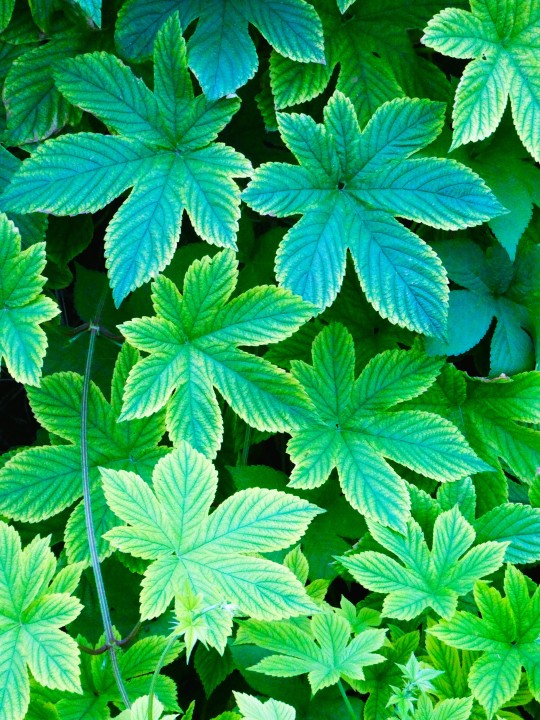

Japanese hop (Humulus japonicus)
50 notes
·
View notes